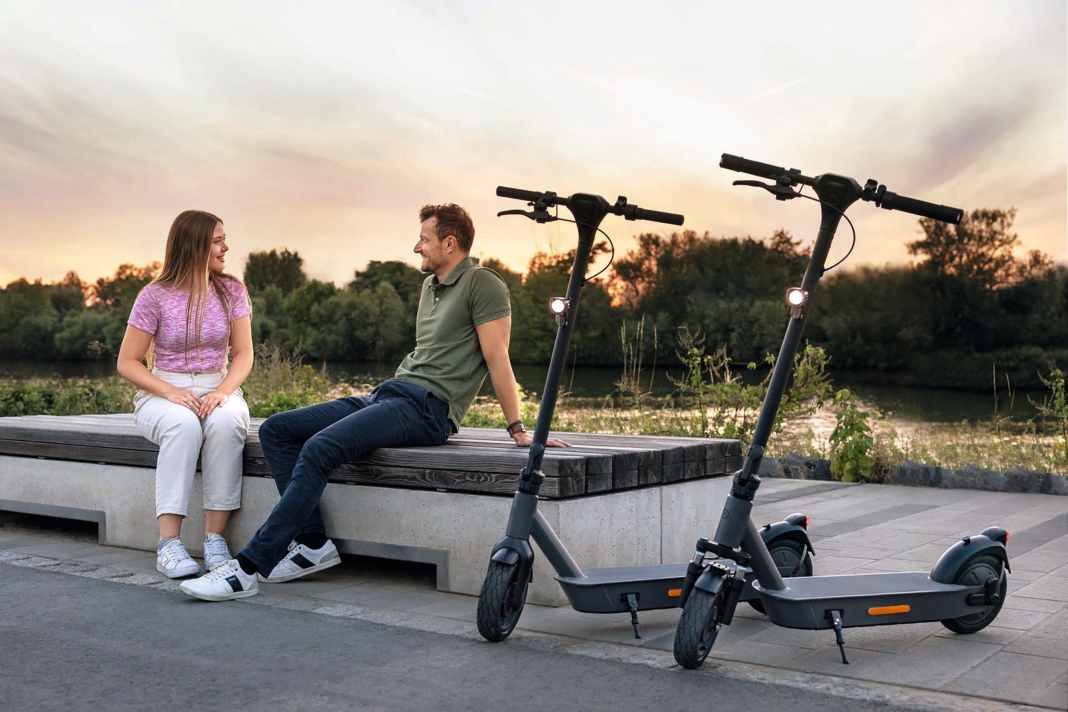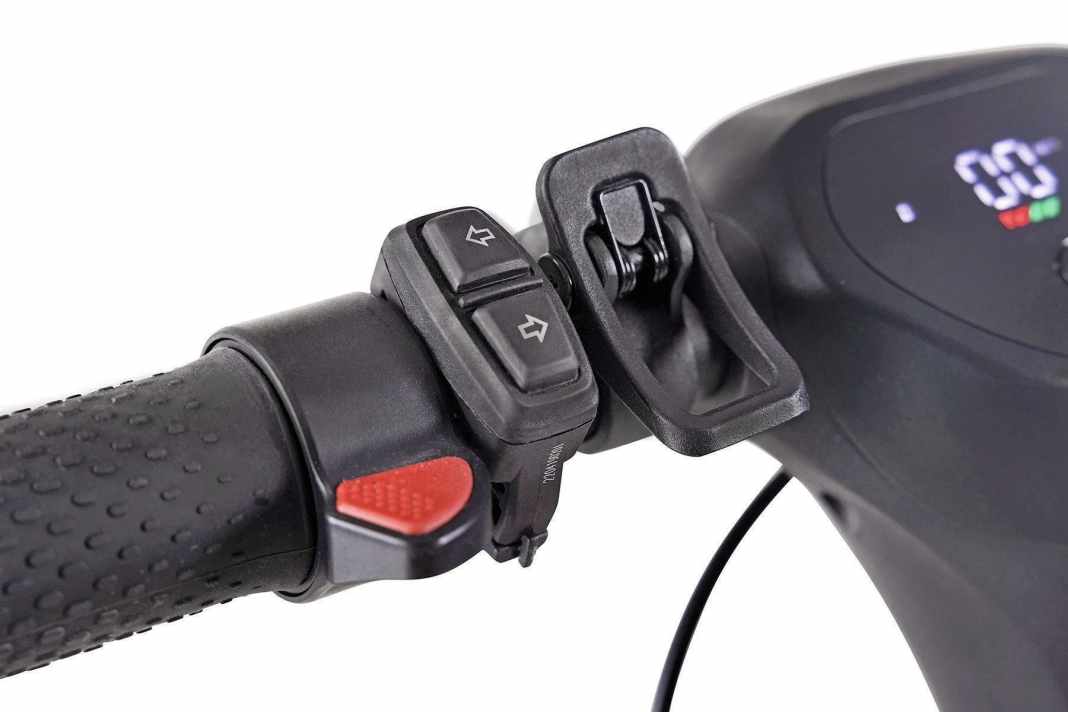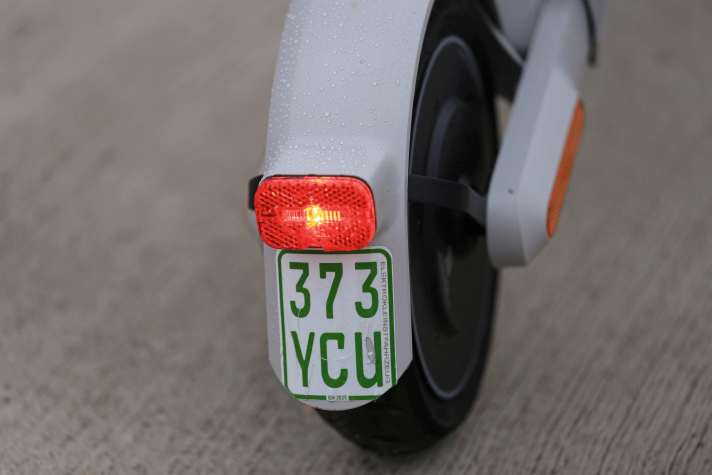





- E-scooter up to 20 kilograms
- The data of the e-scooters in comparison
- Folding or folding mechanism?
- Clever technical details of the e-scooters
- Speed and performance
- Motor, hand and foot brakes
- See and be seen
- Insurance sticker instead of licence plate
- Battery capacity and range
- The tyres determine the comfort
- Great variety, wide price range
- Rules for e-scooters abroad
When it came to compact alternatives to the tried-and-tested folding bike for trips ashore, sporty scooters were all the rage a few years ago. The electric version has now overtaken them. E-scooters have been approved for use on public transport in Germany since 2019. They are an advantage for sailors as they take up little storage space, are ready to go in no time at all and are not too expensive to boot. They are available in various performance and weight classes.
E-scooter up to 20 kilograms
Very robust and ambitiously equipped e-scooters can easily weigh 35 to 40 kilograms. However, more manageable models are more suitable for taking on board a cruising yacht. We have focussed on models up to 20 kilograms in weight limited. After all, they have to be able to be heaved out of the back box and onto land. Most e-scooters in this class are made of aluminium, some are made of a steel alloy. The frame of the Niu KQi Air X is made of carbon fibre.
We have made an exception with the Streetbooster Sirius, which just about breaks the weight limit, but has a removable battery. This means that the scooter and battery can be lifted on or off the deck separately.
Important: If you want to use your e-scooter on public roads in Germany, you must ensure that it has a general operating licence (ABE) for German road traffic. Sometimes additions in the product designation such as DE, eKFV (Elektrokleinstfahrzeuge-Verordnung) or StVZO (Straßenverkehrs-Zulassungs-Ordnung) indicate this. If in doubt, ask the dealer. Other regulations may apply abroad (see below).
The data of the e-scooters in comparison
- A-TO: ULTRON AIR
- Egret: EY! 3 >> available here
- eMicro : EXPLORER S (DE)
- ePowerFun: EPF-1
- ePowerFun: EPF-2 CITY 480/XT 600
- Honeywhale: E9 MAX ABE >> available here
- iScooter: E9T MAX >> available here
- Moovi: PRO S COMFORT CARGO
- Niu: KQI AIR X
- Niu: KQI 100F >> available here
- RCB: EV10K PRO ABE >> available here
- Segway: NINEBOT ES1LD
- Segway: NINEBOT F2 PRO D >> available here
- Soflow: SO2 AIR MAX >> available here
- Streetbooster: PURE FLEX
- Streetbooster: SIRIUS
- SXT : LIGHT PLUS V EKFV
- VMAX: VX2 PER LT/ST/GT >> available here
- Xiaomi: ELECTRIC SCOOTER 4 PRO >> available here
Folding or folding mechanism?
The steering column is usually folded down for stowing in the rear box. Less common is a folding mechanism in which the entire front section is folded down via a hinge in the frame so that the pack size is even smaller in height. In order to reduce the width, a folding handlebar is also required, as is the case with five of the e-scooters presented (see tables on the following pages). This is particularly helpful with wide handlebars. A wider handlebar gives a safer riding experience per se. The ADAC recommends a handlebar width of at least 45 centimetres for e-scooters.
Height-adjustable handlebars, on the other hand, are the exception. We were only able to discover this feature on four of the models. This means: be sure to test ride to see if the scooter fits your body measurements. The same applies to the width of the footboard, which has an influence on stability when riding.
Clever technical details of the e-scooters






Speed and performance
E-scooters that can travel faster than 20 kilometres per hour do not receive an operating licence in Germany. However, there is a ten per cent tolerance, which is why some products are advertised with a top speed of 22 kilometres per hour. The motor is located either in the front or rear wheel. Front-wheel drive improves manoeuvrability, while rear-wheel drive improves weight distribution. Ultimately, the only thing that helps here is to try it out and see which one suits you better.
The maximum rated power permitted in Germany is 500 watts. A good third of the models listed utilise this limit. The cheapest model is the Segway Ninebot ES1LD with 250 watts.
Some manufacturers also provide information on the possible maximum power. This provides information about the power reserves under difficult conditions, for example when starting uphill. The ePowerFun e-PF-2 and the VMAX VX2 Pro take the top spot in this regard with 1,200 watts each.
Unfortunately, not all manufacturers state both values - some only state the rated or maximum power, which makes direct comparisons difficult. Sometimes there is also information on the maximum possible incline, usually in per cent and occasionally also in degrees. As expected, this corresponds to the available maximum power. It is therefore not surprising that the VMAX VX2 Pro is once again ahead in this respect with 28 per cent.
Motor, hand and foot brakes
Two independent braking systems are required. In all the models listed, the drive wheel is fitted with an electronic or electromagnetic brake. This motorised brake is often operated via a slider on the handlebars, called a "thumb brake" - in rarer cases via a regular brake lever, as known from bicycles.
A drum or disc brake with a corresponding brake lever is installed on the other wheel of the majority of products. Disc brakes are considered efficient and reliable. However, the abrasion causes a certain amount of wear. The brake must also be correctly adjusted and occasionally readjusted. Drum brakes are less prone to wear and require less maintenance. However, replacing the brake linings is more expensive.
The engine brake has a softer and more measured effect, although it depends on the setting. If you drive with foresight, you can glide effortlessly through everyday life. It is often referred to as a recuperation brake, as energy can be recovered during braking. However, you should not expect too much from this in terms of battery charging.
A simple mechanical foot brake on the rear wheel, as known from traditional pedal scooters, is significantly less effective. Of the e-scooters listed, only the Segway Ninebot ES1LD uses one as a regular braking system. Otherwise, it can only be found as a back-up braking system, such as on the Moovi Pro S Comfort and the SXT Light Plus eKFV.
See and be seen
Like the bell - or electric horn - the minimum technical equipment includes a white front light and a red rear light. Mandatory indicators for newly authorised e-scooters are still at the planning stage. Indicators are currently still optional, but they can prove helpful in practice. Without electric direction indicators, you always have to stick your arm out when turning, which affects your balance. The indicators are usually housed in the ends of the handlebars.
A brake light, which is usually integrated into the rear light, is also optional. It reduces the risk of rear-end collisions, especially as e-scooters can slow down unexpectedly with their motorised brakes.
Insurance sticker instead of licence plate
Apart from the existence of a general operating licence (ABE) for road traffic, there is no individual registration requirement for e-scooters in Germany. This means that you do not have to register them with the relevant traffic authority and apply for a licence plate. Instead, proof of insurance in the form of an insurance sticker is required.

Before you can set off with your e-scooter, you must therefore take out liability insurance for the vehicle. This is offered by almost all motor insurers and also by some dealers. The costs amount to around 20 to 30 euros per year. Some insurers also offer partially comprehensive insurance with theft protection. The usual premiums for this are between 40 and 70 euros per year.
The insurance sticker must be permanently affixed to the rear of the vehicle. Most e-scooters have a suitable licence plate surface on the rear mudguard for this purpose.
Battery capacity and range
How far you can travel on your e-scooter depends not only on the battery capacity and the total weight, but also on the riding style, the outside temperature, the wind resistance and the surface. Hilly landscapes and regular starts in city traffic drain the battery more than unhindered rolling over flat terrain. The manufacturer's range specifications are only guidelines.
The Soflow SO2 Air Max has the most powerful battery with 17.4 ampere hours. Its maximum range is given as an impressive 80 kilometres - the top value in our market overview. Bringing up the rear in terms of battery capacity are the Niu KQi 100F and the Segway Ninebot ES1LD with 5.1 ampere hours. The latter also has the most modest range of just 20 kilometres. Otherwise, the average value of the listed models is around 40 kilometres.
Unfortunately, exchangeable batteries that can be replaced in no time at all are a rarity in this size and weight class. Of the e-scooters listed, only the Streetbooster Sirius has this feature. The VMAX VX2 Pro is available in three battery versions. The largest is said to be able to cover up to 60 kilometres, but also weighs 20.5 kilograms. The same applies to the XT-600 version of the ePF-2 from ePowerFun with a range of up to 72 kilometres.
In practice, the range can be optimised via a power-reduced operating mode, but this is accompanied by reduced acceleration. Most models offer a choice of two, three or even four power levels. The riding mode is set on the handlebar display or via an app. Such apps also open up additional functions such as updates, maintenance instructions, usage statistics and more. Some even offer an electronic immobiliser.
The tyres determine the comfort
Tyres are of crucial importance for riding comfort. There is a colourful mix of different types - from pneumatic to hollow chamber and solid rubber tyres. The latter are the simplest and cheapest option, but are only able to absorb bumps to a very limited extent. Pneumatic tyres offer significantly more comfort, but are more prone to punctures. There are also tubeless variants ("tubeless"), as we know them from cars. Some are even fitted with a gel under the tyre casing, which is designed to seal off damage automatically.
Air chamber tyres are a middle ground: they do not need to be inflated, but have a honeycomb structure on the inside, which provides better suspension than solid rubber tyres. Sometimes they are also referred to as "honeycombs", which usually refers to tyres with outer holes as air chambers.
Tyre size also plays a role. In addition to better suspension, larger tyres are less likely to bump into things and can overcome obstacles more easily. In our market overview, it ranges between just under eight and ten inches. Some models also come with additional suspension. The spectrum ranges from simple rubber bumpers to suspension elements and suspension forks to damped swing arms on the front and rear wheels. This may seem desirable with solid rubber tyres, but with large pneumatic tyres you can probably manage without it.
Great variety, wide price range
Prices start at just under 350 euros for the iScooter E9T Max and the Segway Ninebot ES1LD and range up to well over 1,000 euros. The expensive models usually have special features. The Niu KQi Air X, for example, stands out with its carbon construction. The Streetbooster Pure Flex is in a league of its own with its special folding technology. And the Moovi Pro S Comfort Cargo from Hanover secures a unique selling point as a cargo transporter.
If you value a solid design and attractive features, including a powerful motor and battery, you should be able to find something from around 600 euros. The cheaper models are more likely to be suitable for the occasional short trip to the bakery on easy routes.
No matter which model you choose, the following always applies: Observe the harbour regulations! E-scooters are not permitted on all jetties and piers.
Rules for e-scooters abroad
Unfortunately, there are currently no standardised regulations for e-scooters in Europe. This starts with the minimum age for use, which is 14 years in Germany, 15 years in Denmark and 16 years in Spain (recommended), while in Austria children as young as 12 are allowed to ride them (with a "bike licence" even from the age of 9). In Denmark, Italy and Croatia, e-scooter riders are also required to wear a helmet, whereas this is not the case in Germany.
The maximum speed limit for scooters also varies depending on the country and sometimes even the region. In Germany, it is 20 kilometres per hour. Elsewhere, such as in Austria, France, Croatia and Slovenia, speeds of up to 25 kilometres per hour are permitted. The insurance obligation is also not uniformly regulated, as long as the vehicle does not weigh more than 25 kilograms or cannot travel faster than 25 kilometres per hour. There are therefore no EU-wide regulations for the models listed in the table below.
Further information on the respective national regulations can be obtained from the European Consumer Centre Germany (www.evz.de; enter the search term "e-scooter"). There you can also find out on which roads you are allowed to ride an e-scooter and which rules of behaviour to observe in road traffic.
As the technical requirements in Germany are comparatively strict, models with a local operating licence should also be able to be used in many other EU countries. The situation is only different in the Netherlands, where most e-scooter models are not permitted on the roads.

